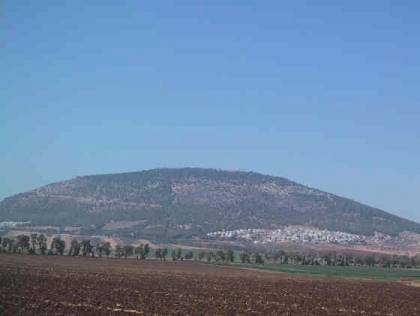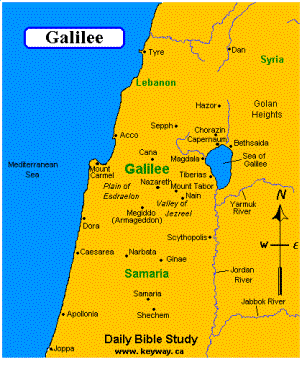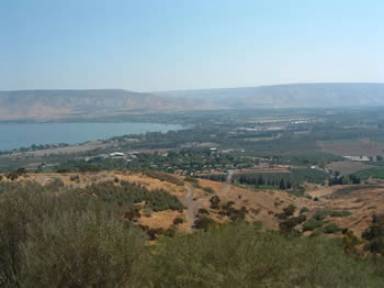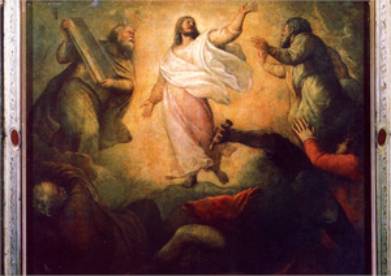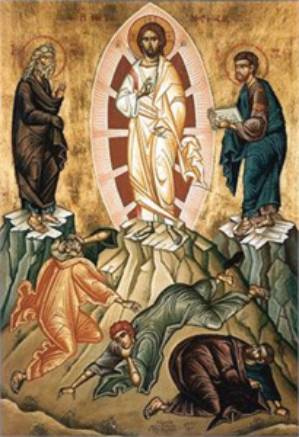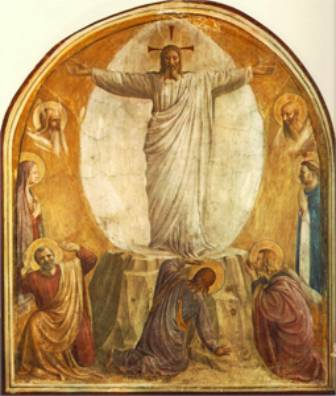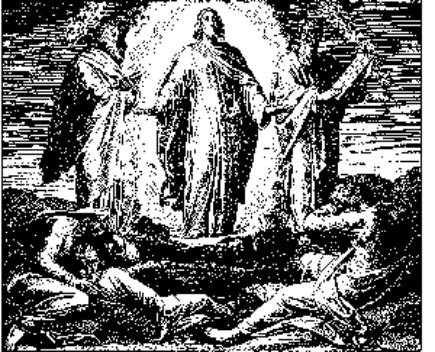
Christmas
Easter
Pentcoest
All Saints
Christ The King
Confirmation
Palm/Passion
Reformation
Stewardship
Books of the Bible
Lenten Series
Christmas Dramas
Videos
Series A - Matthew
Series B - Mark
Series C - Luke
Series D - Other
To contact
Edward F. Markquart
info@sfs.com
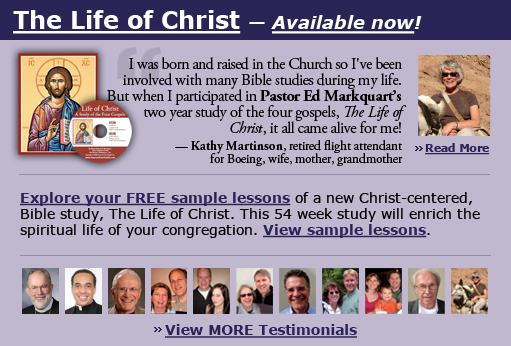
Series B _____________________________________________________ Series A: Matthew 17:1-9 Series B: Mark 9:2-9 Series C: Luke 9:28-36 SYNOPSIS OF THE FOUR GOSPELS, Kurt Aland, English Edition, P. 153-154 This Bible study is from THE LIFE OF CHRIST: A Study in the Four Gospels. This free 54 week course for the laity will be available for congregations beginning in 2007. ______________________________________________________________ #161. THE TRANSFIGURATION Matthew 17:1-9; Mark 9:2-10; Luke 9:28-36 This same story is told in three parallel columns. We know it is the same story. -After six days/eight days. Mark and Matthew work harmoniously together with their specific details and general story line. Luke often seems to have another source whom some scholars call “Proto-Luke.” Consistently, Mark and Matthew offer details that agree with each other (e.g. six days) and Luke has a slightly different detail (e.g. eight days). Both phrases mean, “about a week later.” In other words, the Transfiguration occurred about a week after Peter's famous confession at Caesarea Philippi. -Peter, James and John his brother. These are the important three disciples. That is, we see them together here at the Transfiguration and again together in the Garden of Gethsemane. We recall the numerous stories in the gospels where Peter demonstrates that he is "the leader" of the disciples. From gospel stories, we remember that James and John were the sons of thunder, had hot tempers, were fishermen on the Sea of Galilee, and were the sons of Zebedee and Salome. We remember that traditionally, James is thought to have been become the leader of the church in Jerusalem after Jesus’ resurrection and John became the “beloved disciple” who wrote the Gospel of John. -Jesus lead them to a high mountain apart. A question is asked: Which mountain was the mountain of the Transfiguration? Most scholars give two possibilities: Mount Tabor or Mount Hermon. It seems to me that Mount Tabor is the better choice of locations. Why? Early Church Fathers such as Origen, Cyril of Jerusalem and Jerome identified "a high mountain apart" as Mount Tabor. Also, after the event of the Transfiguration, Jesus goes "on from there and passed through Galilee." (Mark 9:30) Mount Tabor is located in Galilee and so the story flows naturally and geographically from this "high mountain apart" into Galilee. The arguements for Mount Tabor? "Already in Apostolic times the mount of the Transfiguration had become the "holy mount" (2 Peter 1:18). It seems to have been known by the faithful of the country, and tradition identified it with Mount Thabor. Origen said (A.D. 231-54) "Thabor is the mountain of Galilee on which Christ was transfigured" (Comm. in Ps. lxxxviii, 13). In the next century St. Cyril of Jerusalem (Catech., II, 16) and St. Jerome (Ep. xlvi, ad Marcel.; Ep. viii, ad Paulin.; Ep. cviii, ad Eust.) likewise declare it categorically." ... Tthe Synoptics are all explicit concerning the lapse of time, six days, or about eight days including those of departure and arrival, between the discourse in Cæsarea and the Transfiguration, which would infer a somewhat lengthy journey. " http://www.newadvent.org/cathen/15019a.htm The following is a photograph of the rounded Mount Tabor. http://www.gemsinisrael.com/images/gifs/gems_e_a000096511.jpg "Mount Tabor rises softly, but powerfully, from within the verdant triangle of the Jezreel Valley. A uniquely rounded mountain at an altitude of about 1800 feet, its contours may be viewed and unmistakably identified from miles in any direction. The gentle curve of the summit is crowned by an oblong edifice known as the Church of the Transfiguration. This church, built over the medieval remains of an earlier building, commemorates the New Testament story from Matthew 17:1-9, where Jesus is recognized as the Son of God in the company of Moses, Elijah and three of his disciples. Despite a dispute about the actual location of the events from the text, a visit to Mt. Tabor is a highlight on many Christian itineraries - its spiritual significance, the madcap ride to the top and the stunning view from the summit attract multitudes of pilgrims. However, the site is less familiar to Jewish tourists who regularly bypass it, unaware not only of the breathtaking view but also of the Biblical significance of Mt. Tabor." http://www.keyway.ca/gif/galilee.gif Find Mount Tabor between Nazareth and Nain...in Galilee. The following photograph is a view of the Sea of Galilee from Mount Tabor. http://www.sacred-destinations.com/israel/images/mt-tabor/view-galilee-c-pixelchick-350.jpg
-He went on the mountain to pray and as he was praying. Only in Luke. Luke does not say that Jesus led the three disciples up to a high mountain but to “the mountain.” Mark and Matthew are clearer that this was a high mountain apart from everything around, implying a deserted aloneness. Luke twice emphasizes the word, “prayer.” Jesus came to the mountain to pray and as he was praying, his appearance was changed. We have seen that Luke repeatedly emphasizes that Jesus was a man of prayer and that we are to be people of prayer as well. In the Gospel of Luke, we also discover that Jesus was often found praying alone, and we also know that there is a blessing to be gained by being in prayer alone with the Presence of God. In the next story about the healing of the “lunatic” boy, we will hear that the disciple lacked genuine faith and the power of prayer. -He was transfigured before them. The word, “transfigured,” is very important. It comes from a familiar Greek word that is known to us: “metamorphosis.” It means to completely change or transform such as a cocoon transforms into a butterfly or a tulip bulb transforms into a glorious tulip blossom. Jesus’ body was transformed from an earthly body into a heavenly body, from a human body into a resurrection body. It is the teaching of the Bible that our bodies, too, shall be transformed in heaven and that our heavenly bodies will be glorious (I Corinthians 15, the Apostle Paul). -His face shone like the sun. (Matthew). We find the same words in the book of Revelation, that Jesus’ face shone like the sun. -His garments became white as light/glistening and intensely white/dazzling white. It is as if Jesus’ appearance radiates an eternal appearance such as will happen to people when they/we have been raised from the dead and appear before God for all eternity. It seems that in this moment of transfiguration on “the mountain,” Jesus was revealing what people will look like in the grand and glorious future of eternity. In that grand and glorious future, there will be a continued identity but also a transformation into a glorious state of light. Luke uses the identical phrase, “dazzling white,” to describe the two men in the resurrection tomb (Luke 24:4). Also, we hear of stories of people who have “near death” experiences and they often report of seeing bright lights and glowing, radiant figures. -There appeared to them Moses and Elijah. Moses represented the Law or the first five books of the Jewish Old Testament. Moses was the law-giver. Elijah represented the Prophets or the second portion of the Jewish Bible. Elijah was the first and greatest of the prophets. We recall that Jesus often referred to the Law and the Prophets which were the two parts of the Jewish Bible. Moses and Elijah were the two greatest figures in Jewish history. -Who appeared in glory. Only Luke. This is a small insertion by Luke and this small insertion is loaded with juicy tidbits. Highlight the word, “glory,” and also highlight the word, “glory,” four sentences later, “when they (the disciples awakened), they saw his glory.” The Greek word for “glory” is “doxa” from which we get our word, “doxology.” The word implies a shining, radiating, illuminating presence such as is seen in the glory of God, the glorious radiating presence of God. This theme of glory is to remind us that we too will live in glory; that our bodies also will be transformed into glorious bodies that radiate the illuminating presence of God. -They spoke of his departure (exodus) which he was to accomplish in Jerusalem. Only Luke. Just as the Jews in the Old Testament departed (exited) to the Promised Land, so Jesus also was to depart (exit) to the Promised Land. This departure was to happen in Jerusalem, the place of Jesus’ death and resurrection. It was as if Moses and Elijah saw into the future that Jesus would ascend into heaven from Jerusalem. -Now Peter and those who were with him were heavy with sleep, and when they were awakened, they saw his glory. Only in Luke. Peter is singled out from the other two disciples. Once again, Peter’s name and role is highlighted in the story. -And Peter said to Jesus. Peter is obviously the leader and spokesman for the disciples. -It is well that we are here. -Let us make three booths; one for you, one for Moses and one for Elijah. The word, “booths,” is the Greek word, “skaynay” which means tabernacles or tents. We ask a question: “Why would Peter suggest to erect three tents for these three greatest figures of Jewish history out there in the wilderness?” Traditionally, one of the Jewish religious feasts was the Feast of the Tabernacles/Tents in which the Jews remembered that they were out in the wilderness for forty years, living in tents, and that God was with them as they lived in their tents in the wildness. Perhaps, having hiked way out to the wilderness area of Mount Hermon, Peter was reminded of the wilderness stories in the Old Testament, and the festival of the wilderness, the Feast of Tabernacles. Just as the Jews erected tents from tree limbs for the wilderness Feast of Tabernacles, so Peter and the disciples should erect tents in their current situation, to remember God’s miraculous presence with them in the wilderness. That may have been Peter’s logic. -For he did not know what to say. In other words, Peter was stumbling with what he should say, and his previous remarks were an indication that he was befuddled by the events occurring at the moment. -For they were exceedingly afraid. Only in Mark. We have previously witnessed the fear of the disciples, and once again they are afraid of their situation. Why were they afraid? They were afraid of the incoming Presence of God. In a moment, the Gospel of Luke will say, “they were afraid as they entered the cloud.” They were afraid of this cloud, perhaps coming in rapidly and forming a “white out” around them. -A cloud came and overshadowed them. The cloud symbolizes the presence of God. The Jews remembered the Old Testament stories of how God came over them like a cloud in the wilderness. While out in the wilderness for forty years, God came like a pillar of fire by night and a cloud during the day. The cloud symbolized the power and presence of the Almighty God coming upon the Jews wandering in the desert during the day. In a similar way, just as God had come on the Jewish people when they were out in the wilderness, so God was coming to be with Jesus, Moses, Elijah, Peter, James and John in a special way in their wilderness out on the shoulders of Mount Hermon. The cloud symbolized the presence of God. -A voice came out of the cloud. We heard God’s “voice from heaven” during the baptism of Jesus (Mark 3:11 and parallels, page 16) and we hear that voice again, saying the same thing. It is the voice of God who speaks from the cloud. -This is my beloved Son/with whom I am well pleased/my Chosen. Highlight all three parallels. In Matthew, the words are identical in both the baptism and transfiguration: Matthew 3:17, “This is my beloved Son with whom I am well pleased.” God, the Father, clearly expresses the true identity of Jesus. It is God, the Father, who is doing the talking. When God, the Father, talks, everyone is to pay attention and listen. God, the Father, gives the straight scoop: “Jesus is God’s chosen Son.” -Listen to him. Highlight all three parallels. God commands us to listen to the words of Christ. The tense of the verb is present imperative. That is, God is commanding the disciples and the whole world to listen to Jesus. We know that Jesus “has the words of eternal life” (John 6:68) and we are to listen to his words, hear his words, eat his words as if his words were/are the Bread of life and drink his words as if they were the Water of life. Further, we begin to comprehend that Jesus came to heal deaf people, so that deaf people could finally hear. Similarly, Jesus comes to heal people like us who are spiritually deaf to his words, so that we can finally hear the truth in his words. Our ears need to be healed so we can clearly hear the words of Jesus. Just as we closely listen to a doctor when he/she is talking to us about our cancer, our heart attack, our brain aneurysm and just as we often ask our spouses to accompany us so that we have another set of ears to listen accurately to the doctor, so also you and I listen carefully and attentively to the words of Jesus. The voice from heaven declared him to be none other than the Son of God and then commanded us to listen to him. We listen carefully to the words of Jesus. That is what the course is all about. That is what preaching and teaching the Word is all about. -When the disciples heard this, they fell on their faces and were filled with awe. Only in Matthew. The three disciples finally understand. They fell prone to the ground with their faces in the dirt, in reverence and they worshipped him with reverence. Their hearts were filled with awe and God wants our hearts to be filled with awe when we finally comprehend the true identity of this Jesus. When we finally comprehend the true identity of Jesus, we too are filled with reverence and we worship him. -Jesus came and touched them and said, ‘Rise and have no fear.’ Jesus does not want us to be afraid of him either. -They (the three disciples) lifted their eyes and saw no one. Luke’s gospel says, “when the voice had spoken.” It seems as if the event of glorious revelation is now over. -They saw no one but only Jesus. Highlight the words, “only Jesus.” Moses and Elijah are gone. The Law and the Prophets are gone. The two words, “only Jesus,” seem to be an invitation to focus our eyes only on Jesus. We are to keep our eyes solely on Jesus as our Savior, our guide, our wisdom, our direction, our inspiration, our all. -They kept silence and told no one in those days anything of what they had seen. Only Luke. The mood of the sentence is that the three disciples did not tell the others what took place on the mountain…for a while. Eventually, the disciples would tell the story of that glorious revelation of Christ’s glory on the mountain high apart. This becomes part of the Messianic secret. -As they were coming down from the mountain, Jesus charged/commanded them to tell no one… Mark and Matthew. This is the same theme as above in Luke. -The vision/what they had seen. Highlight the word, “vision,” in Matthew. It is usually in the Gospel of Luke that we read about visions. For Luke, vision is a positive word. People have visions and see deeply and clearly into the present moment and into the future. Visions are not a sign of instability but a sign of deep insight into what is happening. Here, it is the Gospel of Matthew who uses the word, “vision.” For Matthew, the three disciples have been granted a vision and have seen clearly and deeply into what had happened to them. -Until the Son of man is raised from the dead. Jesus clearly is referring to himself as the Son of man. But that is not the primary issue. The primary issue is that the Son of man is going to be raised from the dead by the powers of God. But the three closest disciples of Jesus are not to reveal this story of the transfiguration until after the resurrection. -So they kept the matter to themselves, questioning what the rising from the dead meant. This is a nice, juicy, historical remembrance: “They kept the matter to themselves.” Also, the closest three disciples didn’t comprehend about the resurrection. The teaching of the resurrection and the Son of Man rising from the dead was a new concept for them. This is the second time that they have heard this teaching (raised from the dead), the first being during the first passion prediction in the previous story. The three closest disciples were asking: “What does this rising from the dead” mean? We recall Peter’s later recollection about the transfiguration in II Peter 1:16-19,“For we did not follow cleverly devised myths when we made known to you the power of coming of our Lord Jesus Christ, but we were eyewitnesses of his majesty. For when he received honor and glory from the Father and the voice was borne to him by the Majestic Glory “This is my beloved Son with whom I am well pleased,” we heard this voice borne from heaven, for we were with him on the holy mountain. And we have the prophetic word made more sure. You will do well to pay attention to this as to a lamp shining in a dark place until the day dawns and the morning star rises in your heart.” PAINTING AND IMAGINATION: THE TRANSFIGURATION http://easyweb.easynet.co.uk/giorgio.vasari/titian/pic64.htm Titian, 1560-1565
http://htmadmin.phpwebhosting.com/index.html
http://www.wga.hu/frames-e.html?/html/a/angelico/sanmarco/cells/06_trans.html Fra Angelico, 1440-1441
http://www.wels.net/wmc/Downloads/195.gif Julius Schnorr von Carolsfeld, 1851-60
Some people ask, “Why do you think that John does not say anything about the Transfiguration in his gospel?” It seems to me, the best theory is this: In the Gospel of John, Jesus Christ is fully the Son of God from the very first verse and then throughout the whole gospel. Jesus is fully the Son of God. Jesus does not need to be transformed on the mountaintop into the Presence of the Everlasting God because Jesus is fully God throughout John’s whole gospel. Similarly, in the Gospel of John, the disciples do not wrestle with doubt and confusion like they do in the first three gospels. Similarly, there is no temptation story in the Gospel of John nor is there a warfare with the powers of evil (as in the first three gospels.) From the first verse in John, Jesus is triumphant over evil. Since Jesus Christ is fully the Son of God and the disciples know it throughout the whole gospel, there is no need for a Transfiguration story in the Gospel of John. |
